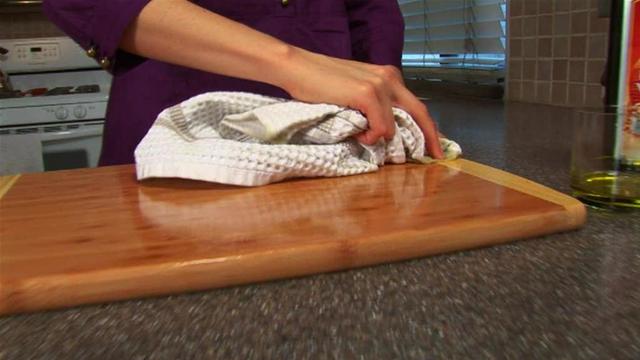They do take some maintenance. Use a mixture of mineral oil and beeswax on your boards.
What About Healthy Safety?
There have been many tests on whether plastic cutting boards are safer from contamination than wood. Most tests prove that wood can actually be safer, finding that plastic cutting boards have a greater bacterial contamination.
How To Maintain, and How Often
Wooden cutting boards need to be kept clean and daily maintenance is often a good scrub with hot soapy water after using. Do not soak your boards or any other wooden utensils in water or they’ll crack and warp! Some people use a very weak bleach solution or hydrogen peroxide to clean their boards after they’ve been used for cutting raw meat as a precaution against bacterial contamination.
Depending on how often you use your boards and wooden spoons, you should also give them an oiling to help maintain their surface and keep them from drying out. About once a month should do, but some people who do it on a weekly basis, depending on how often the FoodBoards are used.
Oiling with Mineral Oil or Spoon Butter
The oil you use for your wooden cutting boards and utensils should be food grade and not prone to rancidity. Mineral oil is an inexpensive and popular choice, and you can easily find bottles in most kitchen supply stores. You can also use a homemade mixture of beeswax and mineral oil, such as this one. In a large sauce pan of boiling water, place a quart mason jar with beeswax (a quarter of a pound) cut into small chunks. Once the wax was melted, place another jar with the 16 ounces of mineral oil in the water to gently heat. Then pour the mineral oil in with the beeswax and allow them to continue to heat and emulsify, gently stirring until smooth and even. Take your jar out of the water bath, allow to cool and it’s ready to use.
There are also brand-name cutting board creams and oils available in kitchen supply stores.
Before you start, be sure your boards are very clean. I like to give them a scrub with lemon and salt, as shown in the method below. The boards should also be dry before oiling, so be sure to build that into your timing. The oil should be left to soak in as long as possible, too. Try to apply the oil in the evening before bed and then just give them a quick wipe the next morning to take off any excess oil.
How To Oil and Maintain a Wooden Cutting Board and Wooden Utensils
What You Need
- Wooden cutting board, spoons, or other utensils
- Clean, soft cloth or paper towel
- Mineral oil or other food-grade oil or favorite mixture
Instructions
- Clean the wood: You want your cutting board and spoons to be as clean as possible and thoroughly dry. Use a half lemon and coarse salt, then wipe it clean, and let it dry thoroughly.
- Apply the oil: Using a clean, soft cloth or paper towel, apply the oil in an even layer over the wood.
- Let it soak in: Leave the oil to soak in, overnight if possible, or for at least a few hours.
- Remove the excess: Using a dry, clean cloth or paper towel, buff off any remaining oil so that the board does not feel damp or sticky.

